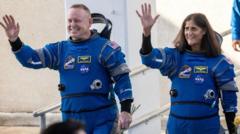The saga of astronauts Suni Williams and Butch Wilmore, who found themselves stranded for nearly ten months in space, highlights the challenges and triumphs of human resilience against the backdrop of space exploration. Their journey unfolded in June 2024 during the first crewed test flight of Boeing's Starliner capsule. As the astronauts approached the International Space Station (ISS), they encountered malfunctioning thrusters that hindered their ability to dock, leaving them uncertain of their return to Earth.
“Docking was imperative,” Wilmore recalled. The threat of being stuck in space permanently was a heavy weight on their minds, yet the duo was careful to keep negative thoughts at bay. “We didn’t communicate the worst-case scenarios,” Williams revealed, emphasizing their training to focus on solutions instead. The two astronauts used their expertise to successfully reboot the thrusters with assistance from Mission Control, ultimately docking safely at the ISS.
What was intended to be an eight-day mission transformed into an unexpected an extended stay. They were unable to utilize the Starliner to return due to safety concerns, opting instead for a SpaceX capsule to bring them home. Despite the immense duration, the astronauts maintained a positive outlook, reassured by their support staff. “We knew we had everyone looking out for us,” Williams stated.
While in this limbo, the astronauts became entangled in external political discussions, with accusations being hurled about their abandonment in space. However, Wilmore pointed out that their focus remained solely on fulfilling their mission. After conducting various experiments during their extended stay aboard the ISS, Williams and Wilmore finally returned to Earth on March 18.
In their months of zero-gravity training, both astronauts developed unique exercise regimens, leading them to emerge from the experience in commendable physical condition. “I returned literally stronger than I’ve ever been,” Wilmore said after performing daily workouts in space. Yet, adapting back to Earth's gravity proved daunting for Williams, who described the sensation of "painful" readjustment.
Back on solid ground, the astronauts are now collaborating with NASA and Boeing to address the technical issues that challenged their mission. With optimism, Wilmore expressed hope for future missions aboard the Starliner, while Williams praised its capabilities and future potential for astronauts. As they look towards the future, both astronauts remain eager and fully ready to take flight again once the issues have been resolved.
“Docking was imperative,” Wilmore recalled. The threat of being stuck in space permanently was a heavy weight on their minds, yet the duo was careful to keep negative thoughts at bay. “We didn’t communicate the worst-case scenarios,” Williams revealed, emphasizing their training to focus on solutions instead. The two astronauts used their expertise to successfully reboot the thrusters with assistance from Mission Control, ultimately docking safely at the ISS.
What was intended to be an eight-day mission transformed into an unexpected an extended stay. They were unable to utilize the Starliner to return due to safety concerns, opting instead for a SpaceX capsule to bring them home. Despite the immense duration, the astronauts maintained a positive outlook, reassured by their support staff. “We knew we had everyone looking out for us,” Williams stated.
While in this limbo, the astronauts became entangled in external political discussions, with accusations being hurled about their abandonment in space. However, Wilmore pointed out that their focus remained solely on fulfilling their mission. After conducting various experiments during their extended stay aboard the ISS, Williams and Wilmore finally returned to Earth on March 18.
In their months of zero-gravity training, both astronauts developed unique exercise regimens, leading them to emerge from the experience in commendable physical condition. “I returned literally stronger than I’ve ever been,” Wilmore said after performing daily workouts in space. Yet, adapting back to Earth's gravity proved daunting for Williams, who described the sensation of "painful" readjustment.
Back on solid ground, the astronauts are now collaborating with NASA and Boeing to address the technical issues that challenged their mission. With optimism, Wilmore expressed hope for future missions aboard the Starliner, while Williams praised its capabilities and future potential for astronauts. As they look towards the future, both astronauts remain eager and fully ready to take flight again once the issues have been resolved.




















